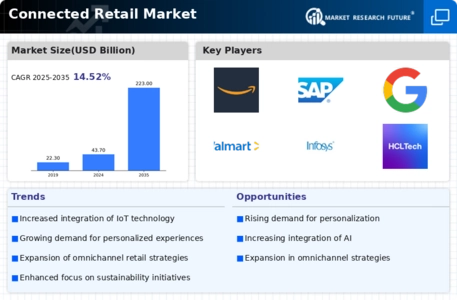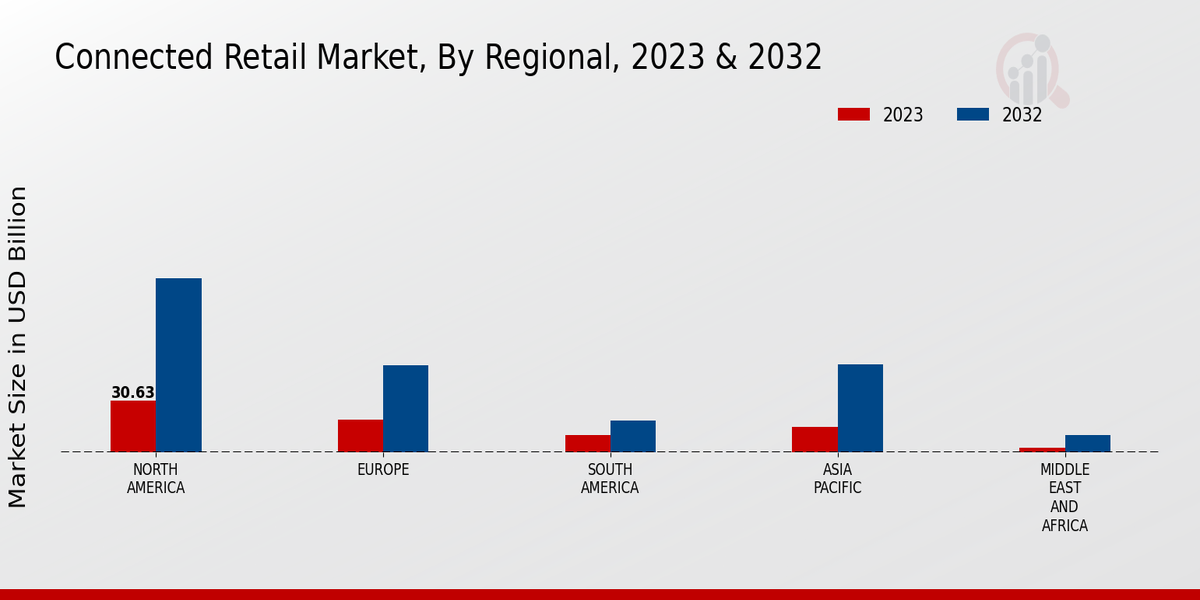Omni-channel Retailing
The Global Connected Retail Market Industry is witnessing a surge in omni-channel retailing, where retailers integrate multiple sales channels to provide a seamless shopping experience. This approach allows consumers to interact with brands through various platforms, including online, mobile, and physical stores. Retailers are investing in technologies that facilitate this integration, such as unified commerce platforms and customer relationship management systems. As a result, the market is likely to benefit from enhanced customer engagement and loyalty. The projected compound annual growth rate of 15.98% from 2025 to 2035 underscores the potential of omni-channel strategies in driving market expansion.
Market Growth Projections
The Global Connected Retail Market Industry is poised for substantial growth, with projections indicating a rise from 43.7 USD Billion in 2024 to 223.0 USD Billion by 2035. This trajectory suggests a compound annual growth rate of 15.98% from 2025 to 2035, reflecting the increasing adoption of connected technologies across the retail sector. Factors such as technological advancements, consumer demand for personalization, and the rise of omni-channel retailing are driving this growth. As retailers continue to innovate and adapt to changing consumer preferences, the market is likely to expand, presenting opportunities for stakeholders across the industry.
Technological Advancements
The Global Connected Retail Market Industry is experiencing rapid growth driven by technological advancements. Innovations such as the Internet of Things (IoT), artificial intelligence, and machine learning are revolutionizing retail operations. Retailers are increasingly adopting smart shelves, automated checkout systems, and personalized marketing strategies, enhancing customer experiences. For instance, IoT-enabled devices allow for real-time inventory tracking, which can reduce stockouts and optimize supply chains. As a result, the market is projected to reach 43.7 USD Billion in 2024, indicating a robust demand for connected retail solutions.
Increased Focus on Sustainability
Sustainability is becoming a pivotal driver in the Global Connected Retail Market Industry, as consumers and retailers alike prioritize eco-friendly practices. Retailers are adopting sustainable sourcing, reducing waste, and implementing energy-efficient technologies to appeal to environmentally conscious consumers. This shift not only enhances brand reputation but also aligns with regulatory pressures for sustainable practices. As sustainability becomes a core component of retail strategies, the market is expected to evolve, with significant investments in green technologies and practices. This trend may contribute to the overall growth of the market, as consumers increasingly support brands that demonstrate a commitment to sustainability.
Data Security and Privacy Concerns
In the Global Connected Retail Market Industry, data security and privacy concerns are emerging as critical drivers influencing consumer trust and retailer strategies. With the increasing reliance on connected technologies, retailers must prioritize safeguarding customer data to maintain confidence. Implementing robust cybersecurity measures and transparent data handling practices is essential for mitigating risks associated with data breaches. As consumers become more aware of their privacy rights, retailers that demonstrate a commitment to data protection may gain a competitive edge. This focus on security is likely to shape the future landscape of connected retail, influencing consumer behavior and market dynamics.
Consumer Demand for Personalization
In the Global Connected Retail Market Industry, there is a noticeable shift towards personalization as consumers increasingly seek tailored shopping experiences. Retailers are leveraging data analytics to understand customer preferences and behaviors, enabling them to offer customized recommendations and promotions. This trend is particularly evident in e-commerce, where personalized marketing can lead to higher conversion rates. As consumers continue to prioritize unique experiences, the market is expected to grow significantly, with projections indicating a rise to 223.0 USD Billion by 2035, reflecting the increasing importance of personalized retail strategies.



 Source: Primary Research, Secondary Research, MRFR Database and Analyst Review
Source: Primary Research, Secondary Research, MRFR Database and Analyst Review













Leave a Comment